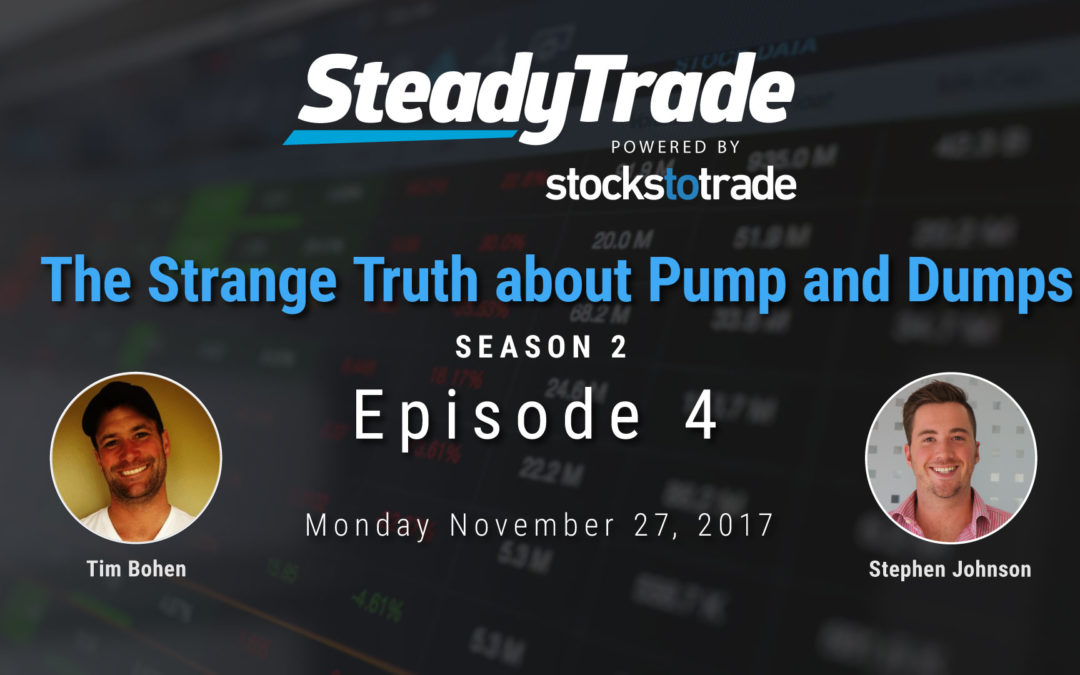In Season One of the Steady Trade Podcast, hosts Tim Bohen and Stephen Johnson offered a foundational education on important things that every new trader needs to know. In Season Two, they are continuing to build on that education by teaching you what you need to do to springboard from education to actual trading.
One of the main things you’ll need to successfully transition from student to day trader is a strong understanding and mastery of patterns. While to a certain degree this is something you’ll learn over time, there are several key patterns that repeat themselves so frequently that you need to know about them. One such pattern, and the subject of Episode Four, is the pump and dump.
What is a pump and dump?
This jitter-inducing term is thrown around a lot in trading. But what exactly does it mean?
In essence, a pump and dump is a controlled inflation of a stock’s price. Typically, it’s engineered by individuals who have access to a lot of the stock and want to raise its value. However, the actual production will likely involve many players; it might be initiated by a shareholder, but then executed by promoters.
They will knowingly inflate stock prices through various promotional efforts (the “pump”). Once the stock’s value has been raised considerably, the aforementioned individuals unload the stock rapidly and in great quantity, earning profits for themselves but overall lowering the value of the stock for the others who bought in and helped raise the price (the “dump”).
The evolution of pump and dumps.
When many people think of the pump and dump scheme, they think of a boiler room format, a la The Wolf of Wall Street. However, pump and dumps aren’t always quite so blatant, nor are they conducted by smooth-talking salesmen in dimly lit boiler rooms.
In the 90s, pump and dumps migrated to the internet. Emails, chat rooms, online forums, and hard copy mailers would be used to inflate the prices. Today, pump and dump inflation efforts might be conducted via internet channels and social media channels. Because of this, it’s not always easy to instantly pinpoint what is and what is not a pump and dump.
Identifying pump and dumps.
Identifying pump and dumps isn’t always as easy as it sounds.Promoters have gotten smart to the fact that a big and rapid spike is a red flag. As such, these days, many pump and dumps are engineered to “walk” or have a more gradual price raise. Basically, they want to keep people in until they are ready to sell.
In the episode, Tim and Stephen offer some specific tips on how to identify pump and dumps, and offer advice on how they have changed over the years. They also offer tips for how to get an edge on it so that you can begin to follow a successful model for trading pump and dumps and formulating a plan.
Using pump and dumps to your advantage.
In the podcast, Tim and Stephen talk about successful traders like Tim Grittani and Tim Sykes have used pump and dumps to their advantage. They discuss specific approaches and ways in which these traders have gained an edge which has helped pump and dumps make them money.
Do you want to use pump and dumps to make money? Time, technique, and lots of research are necessary to make it work. Tim and Stephen discuss the pros and cons of working with pump and dumps and offer some great advice for how you, as a trader, can consider if this is the right direction for you.
Remembering your foundation.
Tim passes on a saying that “Markets can stay irrational longer than you can stay solvent.” Remember: you can be right about identifying a pump and dump. However, unless you get in at the right time, you can lose a lot of money. By remembering your foundation and following Tim and Stephen’s tips to figure out a specific plan, you can reduce the risk that comes with investing in pump and dumps.
Win big!
A new season of the Steady Trade Podcast means an all-new giveaway, including a Stephen Johnson pillowcase (and, you know, other things like a Macbook pro, an Apple TV device, an iPod touch, an Apple Watch, a $100 gift card, and 3 months of Stocks to Trade). Just like in Season One, there’s also another “Greedy Little Bastard” prize, which includes all of the aforementioned items!
Visit our giveaway page for more information, and stay tuned for Episode 5!




I was a very new trade when EMMD and I wasn’t in on that but did make some on LRTTF. I should have made it a swing for a few days but didn’t. I did get in at the panic and a few days later and made a few dollars. Love your podcast they have so much info and I feel I learn more from them. Thanks Tim and Stephen
Thanks again for everything I hope I win the greedy little bastard package because I am one greedy little bastard LOL and I can’t wait to work with you guys
Thanks Patrick and good luck!
Great episode! Pump and dumps don’t act like they used to, adapt to the market! I look forward to coming home from work on Mondays and listening in! Thanks guys!
Thanks for the comments Dustin, glad you find the podcast useful!
Nice episode guys, very helpful! Thanks!
Great to hear! Thanks!
Thanks guys
Nice info on pump and dump, have not done any shorts but would like to start shorting some time . very helpful education.
Glad you found it educational Asmita, thanks!
I always enjoy the banter between you two as you dish important info to the audience. Keeping it light while delivering is an art that you both possess. Thank you for all your efforts, it is obvious Tim it is your passion.
Thanks! Yeah talking about stocks is for sure my favorite thing to do 🙂
Thank you TBohen and Stephen for another great podcast! I always take notes on your podcasts, it became a part of my learnings with Tim’s Challenge. TBohen, you have so much knowledge, I appreciate you are sharing them. Thank you 🙂
The jokes and the overall tone of that episode! I have been following Tim for a year now so that episode was a good refresher of this niche. Thanks for that, always a pleasure to hear you guys roast each other when I’m stuck in traffic!
Thanks Lorenzo!
Great episode! Always a pleasure to both learn and be entertained while stuck in traffic!
Perfect 🙂
You guys are hilarious yet informative. Thanks for the entertainment as well as all the great info❗️
Thanks Laura thats our goal! To be educational but entertaining too!
Thanks for this review on P&D. I’m always impressed by those that have the edge to ride it up and down on the same stock. I’m still learning on being a great shorter and looking forward to future episodes on that.
Everything about “pump and dumps” was very informative. I like how Tim and Stephen presented things in a serious but casual way. It’s all about the learning process and preparing. Just remember that this is a “JOURNEY” especially to us newbies out there. Thumbs up guys and keep it up!!!!
Thanks Marion!! Love the constructive input!
I look forward to each episode. There is always some gold nuggets that pop out of nowhere that have really good information. Thanks guys!
Im a greedy little bastard!!! Only because i never win at anything?? Could this be the year first time, loosening at very pump and dump. Trying to be a greedy little bastard win some thing!!! No chance in hell??
Thanks you greedy bastards keeping it real!!! Happy Holidays You Bastards. 🙂
Haha, thanks Raymond!
Love your podcasts!
Thanks!
thank you guys these have been very helpful for me, i don’t care as much about the other prizes but i hope i win STT subscription 😁